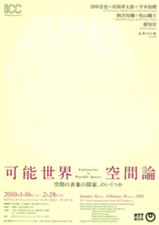NTT InterCommunication Center [ICC] is pleased to hold the "Exploration in Possible Spaces" exhibition.
Today, through virtual space technology, it is possible to simulate the natural environment and social composition. How, then, does the Metaverse-a 3D virtual space constructed on the Internet-differ from the real world, and consequently, what kinds of things can be envisioned for this space?
The ICC Metaverse Project was launched as a long-term project with the theme of discovering how the Metaverse can be utilized. By reexamining the Metaverse from the standpoints of virtual space as construction space for art and design engineering, of the relationship between the physical and the virtual, of virtual space as a communication platform, and of information society theory, the project aims to verify the potential of the Metaverse using various methods under a series of plans, including discussing the problems entailed in the above concepts in workshops and holding exhibitions to put these concepts into practice.
As changes in urban space are often discussed in relation to changes in social structure, both our perception and world view have changed with the new ways in which we have conventionally conceived space. From the establishment of acentric universal space after modernism, toward the discrete and nonlinear space of the Internet age, what changes has the new concept of space wrought in our thinking? It can be said that this is being expressed all the more conspicuously now, as changes in real-life society structure are suggested by architecture formed in the information space known as the Internet.
This special exhibit aims to expand the focus of the Metaverse Project to include the testing and implementation of social design by seeking new spatial recognition using methods such as Internet architecture and computation based on discussions conducted during Metaverse study sessions and presenting "possible spaces" actualized through this relationship. Please enjoy the various "Quests for Spatial Representation" undertaken by the four groups of participants.


